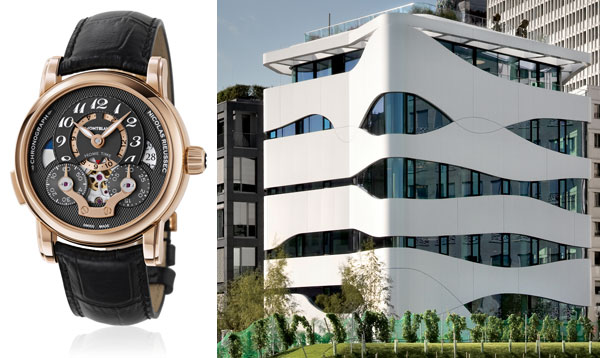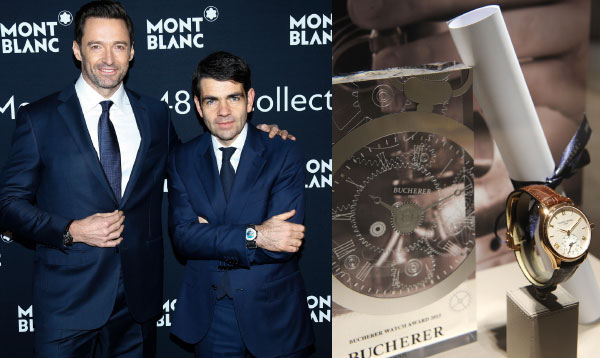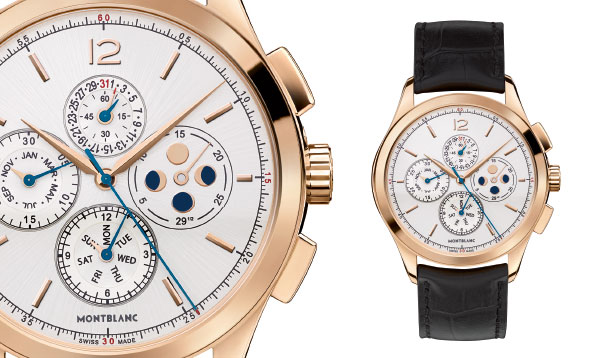
The watch : Nicolas Rieussec Chronograph Open Hometime
Well-travelled people who spend as much time among the clouds as they do with their feet firmly on the ground will find this new variation on the chronograph very appealing. Following its 2011 tribute to French watchmaking great Nicolas Rieussec, the inventor (in 1821) of the first chronograph consisting of a rotating disc and a hand with an ink reservoir, the white star brand is revisiting the GMT function with its Nicolas Rieussec Chronograph Open Hometime model. At first glance, the new arrival stands out from other chronographs in that it has a single pushpiece at 8 o’clock to control the start, stop and reset functions. Another significant difference is that it does not have a large central second hand. Instead, two rotating discs serve as totalisers and evoke Nicolas Rieussec’s original chronograph. Nestled in a red gold case, the charcoal-gray dial shows other unique features. An off-centre hour hand and a second time zone visible through circular cut-outs to the inside of the hour scale create an original display for the function most sought after by seasoned globetrotters. This is an exceptional piece that gives an elegant, sporty impression.
Its architectural counterpart : the Otto Bock Foundation Science Centre Medical Technology, Berlin, Gnädinger Architekten
The Otto Bock Foundation Science Centre Medical Technology building in Berlin, located between Potsdamer Platz and the Brandenburg Gate, was built to house what is essentially a spare-parts centre for the human body. With help from other associations, the foundation has gained a space for introducing prostheses for testing by the disabled. With this in mind, by the architects’ own admission, the building as planned was designed to be an allusion to human muscle fibres, and so a reminder of the purpose for which it was built. Taking this idea as a starting point, the facades dreamed up to envelop the structure’s six floors resemble superposed white ribbons. The freeform curves (splines) are intended to recall the complexity of certain parts of the human body. They are used to conceal the openings through which natural light enters the building, and to provide equal illumination for all of the spaces on the different floors. The organic metaphor used for the Otto Bock Foundation’s building is shared by the image given for the Montblanc watch – an object with an aesthetic aspect that goes beyond the mere purpose it was created to serve, leaving us free to understand the object’s form through another, more playful possible interpretation born of an imaginary and more childlike world.
Nicolas Rieussec Chronograph Open Hometime
Movement : automatic winding, Montblanc MB R210 calibre, 72h power reserve Case : red gold Diameter : 43mm Functions : second time zone, day/night indicator, date on rotating disk, chronograph Caseback : sapphire crystal Strap : black alligator leather Water resistance : 30m
Cartier
The watch : Rotonde de Cartier Tourbillon Cadran Lové, 9458 MC calibre
This is indeed a Rotonde de Cartier, no doubt about it! The style is there, recognisable at first glance. Notwithstanding, inside the elegant white gold case is an original aesthetic that gives an ingenious flying tourbillon its due. The Rotonde de Cartier Tourbillon Lové displays the queen of all complications at the centre of an “arena” formed by a solid-gold chased pierced grill with Roman numerals. This painstaking graphic style leads the eye in a vertiginous plunge down to where the tourbillon carriage actually seems to “float” over the bridges, as if resting weightlessly above the dial. This position makes it more vulnerable to shocks that might throw it out of balance; while the arrangement is more beautiful, it is technically more difficult, which means that the master watchmakers had to give the carriage’s design their full attention. At the centre of the 46.20 mm white gold case, the carriage reflects the ticking of the 9458 MC calibre movement, which bears the Hallmark of Geneva. This piece is a clear expression of Cartier’s virtuosity in creating fine watches.
Its architectural counterpart : the Zollverein School of Business Management and Design, Essen, Sanaa
This structure was created in 2006 by architects Kazuyo Sejima and Ryue Nishizawa of the Sanaa firm in Tokyo. It stands on the site of a former coal mine in a suburb of Essen. It was designed as a cube 35 metres on a side, with four floors of different heights and a roof garden, a simple shape that accommodates the variously-sized spaces inside the school. The facades are perforated by 134 openings for windows of different dimensions, creating varied lighting conditions within the building’s spaces. The openings in the reinforced-concrete shell have been adjusted to optimise natural lighting in each area of the building and
provide a changing view of the surrounding landscape. The building’s facades reinterpret windows to invite a very distinctive “reading” of the object: the openings are randomly placed in the wall and appear to have no relation to the structure’s internal arrangement. This very formal composition, which is asymmetrically placed with respect to the plane of the facades, strives to play on the volume’s edges as though the architects were trying to tell us a secret: the treatment of the facades is supposed to reveal the cube that is the whole reason for the structure’s existence. The Cartier watch suggests a similar distinctive approach. The hour indicator elements are not centred on the dial, being positioned on a corner of the watch. The asymmetrical composition succeeds in drawing the observer’s attention to the unusual position of the watch elements.
Rotonde de Cartier Tourbillon Lové
Movement : manual winding, 9458 MC calibre, Hallmark of Geneva, 50-hour power reserve Case : white gold Diameter : 46.20mm Functions : hours, minutes, flying tourbillon Caseback : sapphire crystal Strap : semi-matte black alligator leather Water resistance : 30m Limited edition : 100 pieces







